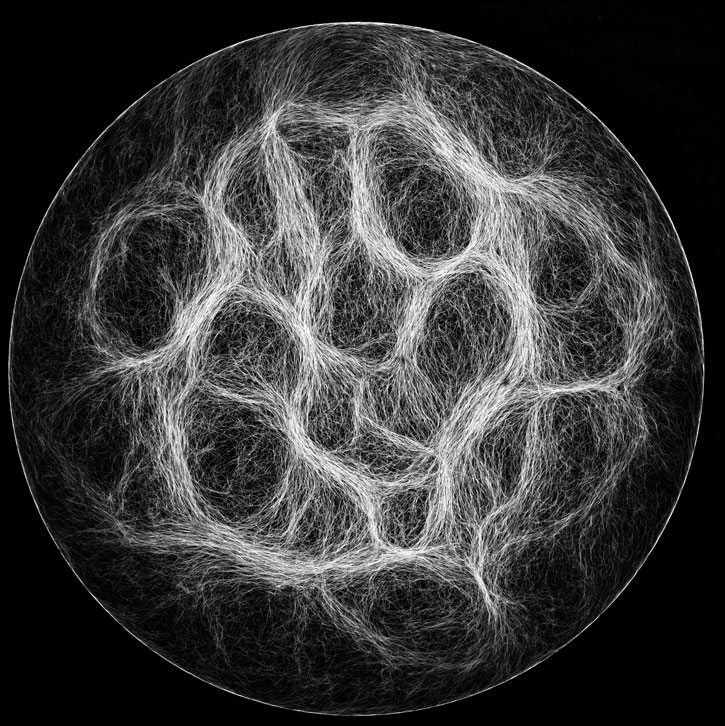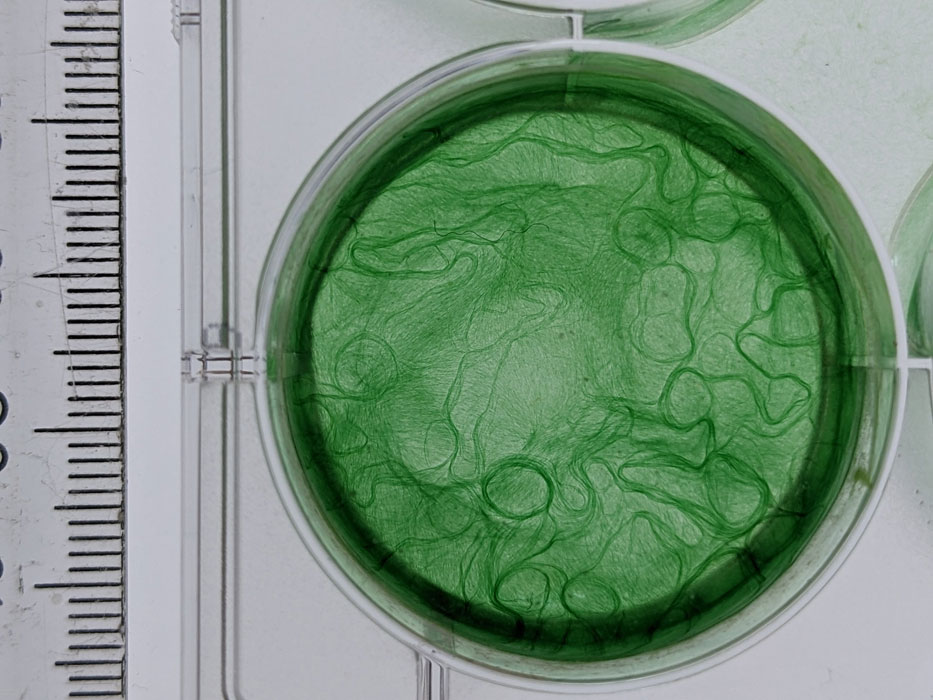All Bundled Up
By Cullen Walsh
Colonies of stringy bacteria form collective patterns that help them respond to their environment.
August 16, 2024
From The Staff Biology Physics Microbiology Zoology
Mixon Faluweki shook a bottle filled with cyanobacteria (also known as blue-green algae) until it formed a green slurry. He then put a few drops of the slurry into a dish and left it sitting in an incubator for a few days. When he returned, he placed the sample under a microscope and saw that the colony of cyanobacteria had naturally formed a beautiful honeycomb-like pattern along the surface of the dish. Colonies of cyanobacteria have been forming similar patterns for billions of years, making them one of the earliest examples of complex life. But the mechanism behind this collective pattern formation has remained unknown until recently. Using observations and mathematical modeling, Faluweki and his collaborators have now discovered what it is about these microscopic colonies of cyanobacteria that causes this intriguing behavior.

M. K. Faluweki, et al., 2023, Physical Review Letters 131:158303.
Cyanobacteria are one of the earliest forms of multicellular life. Faluweki, a biophysics graduate student with Lucas Goehring at Nottingham Trent University in the United Kingdom, studies filamentous cyanobacteria, named for their ability to form long, spaghetti-like chains of cells known as filaments. Researchers have known for some time that colonies of filamentous cyanobacteria tend to form collective patterns. Indeed, similar patterns to those observed by Faluweki have been found in biofilm fossils that are more than a billion years old. To uncover the process behind these patterns, Faluweki, along with Jan Cammann, a mathematics graduate student with Marco Mazza at Loughborough University, paired together their expertise in imaging techniques and computational modeling. As they reported in Physical Review Letters, Faluweki, Cammann, Mazza, and Goehring found that collisions between the head of one cyanobacteria filament and the body of another are key in the development of these patterns. These occasional interactions cause the cyanobacteria to align, leading to the formation of large bundles of filaments. These bundles then naturally organize into the collective patterns that the researchers observed under the microscope.
M. K. Faluweki, et al., 2023, Physical Review Letters 131:158303.
The researchers started by imaging colonies of Oscillatoria lutea, a typical strain of filamentous cyanobacteria, using fluorescence microscopy. Cyanobacteria are packed full of fluorescent chlorophyll, causing them to emit red light when illuminated with certain wavelengths of electromagnetic radiation. As a result, when the researchers imaged colonies of cyanobacteria, they appeared as bright red lines. Using this technique, the researchers observed how individual cyanobacteria filaments interact. They found that a lone cyanobacterium filament will glide along a surface in smoothly curving circles, with its body following its head as it moves in a clockwise motion. If that cyanobacterium approaches others, it will tend to glide either over or under those filaments around it. “They are covered in slime, so there is basically no friction when they meet, and they have a very easy time passing over each other without disturbance,” Mazza says. However, on occasion, the researchers observed that the head of one cyanobacterium will collide with the body of another at a slight angle, causing the two to travel along the same path for a few hundred micrometers before diverging once again.

M. K. Faluweki, et al., 2023, Physical Review Letters 131:158303.
Although this type of interaction only occurs around four percent of the time, it has a dramatic influence on the collective behavior of the colony. At low density, these interactions are too infrequent to have an effect, leading to a disordered colony. However, as the density increases, the cyanobacteria begin to collide more, which causes them to straighten out and move in parallel to their neighbors in larger groups, and over time this behavior causes them to align into large bundles that arrange into these distinctive clustered patterns. By modeling the cyanobacteria using the observations from their experiments, the researchers were able to replicate this density-dependent effect and successfully predict the density at which this collective behavior will emerge.
M. K. Faluweki, et al., 2023, Physical Review Letters 131:158303.
Part of what makes these collective patterns important is their ability to enhance the responsiveness of the whole colony. For instance, colonies of cyanobacteria in nature can bundle together into a sheet, often called a biofilm, which can then respond very quickly to external stimuli, says Mazza. This formation, for instance, allows the colony as a whole to rapidly shrink away from intense sunlight. In comparison, cyanobacteria in a disordered colony will try to react individually, resulting in a collective response that is less efficient. “The way I think of this is, if you take a wool sweater, it’s knitted. If you put it in hot water, it will shrink rapidly. A similar process takes place in these biomasses; but unlike the sweater, it is an active process. If they change how they interact with one another, they can cause that network to collapse or grow on scales which are hundreds or thousands of times faster than the individual filaments will move,” Goehring explains. “It is the same reason why we weave or knit fabric into textiles—it gives structural function,” Mazza adds.
M. K. Faluweki, et al., 2023, Physical Review Letters 131:158303.
These results are particularly intriguing, the researchers say, because they demonstrate how organization arose in an ancient form of multicellular life. “As a theorist, I like the fact that you have shape or form that leads to function,” Mazza says. “You start with interactions, you put a lot of things together, you step back and what you see is a new level of emergent behavior,” Goehring adds. “So, we are showing how to connect the microscopic individual interactions to the higher-level architecture of a very early and very successful form of multicellularity.”
American Scientist Comments and Discussion
To discuss our articles or comment on them, please share them and tag American Scientist on social media platforms. Here are links to our profiles on Twitter, Facebook, and LinkedIn.
If we re-share your post, we will moderate comments/discussion following our comments policy.